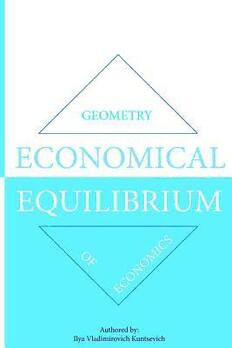
Economical Equilibrium: Geometry of Economics PDF
Preview Economical Equilibrium: Geometry of Economics
Economical Equilibrium: Geometry of Economics ILYA VLADIMIROVICH KUNTSEVICH Copyright © 2013 Ilya Vladimirovich Kuntsevich www.economicalequilibrium.com All rights reserved. ISBN: 1492387517 ISBN-13: 978-1492387510 To my parents, Vladimir and Galina, for all their blessings To my brother, Rostislav, for his spiritual support To my wife, Galina, for her love, and To my children, Anna, Vera and Ivan, for their inspiration and joy CONTENTS ACKNOWLEDGMENTS PREFACE PART I: FUNDAMENTALS WHAT DRIVES ECONOMICS VALUE MONEY VALUE-ADD = PROFIT = INFLATION DEBT BANKS, LOANS AND INTEREST “VALUABLE” ACCOUNTING EQUITY AND IPO PUBLIC STOCK MARKET GOVERNMENT AND TAXES CURRENCY PURCHASING POWER PART II: GLOBAL ECONOMY ECONOMIC GROWTH INTERNATIONAL RESERVES PENSION FUNDS AND SOCIAL SECURITY PEOPLE AND JOBS EDUCATION WEALTH DISTRIBUTION FRACTALS IN ECONOMICS TIME BOMB PART III: ECONOMICAL EQUILIBRIUM GEOMETRY OF ECONOMICS CASH VALUE RATIO VALUE RETENTION RATIO BALANCED GROWTH MODEL IS A COUNTRY IN GOOD “SHAPE”? WHAT GENERATES A CRISIS? BEST AND WORST STORAGE OF VALUE TEN POSTULATES OF ECONOMICAL EQUILIBRIUM BACK TO THE FUTURE INSTEAD OF IN CONCLUSION BIBLIOGRAPHY ABOUT THE AUTHOR ACKNOWLEDGMENTS I would like to thank everyone who inspired and supported me in the creation of this book and helped to get it published. A special THANK YOU goes to Professor William Cockrum, Roman Abdulin, Philip Landau, Frederick Elsea, Professor Edward Leamer, Keith Lupton, Cody Franklin, Joshua Nip, Professor Eric Sussman, Allen Morgan, Bill Gross, Marcia Goodstein, Professor Jeff Scheinrock, Natalia & Dmitry Arkhipenko, Professor Lawrence Wright, Ivan Lee, Timur Rodionov, Royce Disini, Wilton Risenhoover, Anatoly Miliukov, Leo Petrossian, Robert Hamilton, Dan Hanchey, Student Investment Fund of UCLA Anderson and UCLA Anderson School of Management Executive MBA Class of 2010. PREFACE Modern economics is a focus of many people, especially in the aftermath of the 2007–2008 financial and economic crisis. One has to wonder – what’s wrong with the economic system if it breaks down now and then? Should the modern economic theories, accounting principles and financial models be relied upon going forward? Could we devise an alternative economic system, which would be whole and sustainable, and allow a crisis-proof pace of economics? Could we design and build more intelligent tools and models in order to see the big picture and avoid future crises? This book initially came about as a way to identify the root cause of an economic crisis. Only by taking something that doesn’t work apart, can we see the root cause of the problem. Therefore, the book starts with the fundamentals of economics, accounting and finance, exposing some of their obvious flaws and misconceptions, and continues with the analysis of the global economy’s modern condition. As the book has progressed, Economical Equilibrium theory has evolved as a new economic system, assisted by geometry. A visualization technique, which allows identification of the cause and effect relationship using geometrical figures, rather than linear mathematics, aids Economical Equilibrium theory in multiple applications across all levels of economics. Using its ten postulates, Economical Equilibrium theory is capable of both identification and prevention of economic crises, as well as effective design and management of sustainable economic activities. I also make certain recommendations on changes to the fundamentals of accounting principles and financial models, which should add transparency and accountability thereof. If followed diligently, these recommendations will alleviate concerns of people on the future of the global economy, and their individual well- being. PART I: FUNDAMENTALS What Drives Economics Economics is a reflection of people’s activities; it is a mirror of what we do. Convenience, sense of accomplishment, satisfaction and aspirations are the key drivers of any economic system, because the world is driven by the desires of people to live a life they want – more comfortable, more satisfying to their needs and values. Modern economics is reflected by what is measured and exchanged quantitatively; the language of economics is numbers, currency and graphs. An argument could be made that satisfaction doesn’t always come from the items that can be measured (e.g. with money). For example, love, conscience, friendship and happiness are invaluable features of our lives and provide infinite internal satisfaction. Nevertheless the external side of human nature doesn’t change – as if we are “programmed” to look for better living conditions and improve them to our desires, should an opportunity arise. A house, heating, transportation, supermarkets, telephone, internet – these are habitual representations of our modern civilization’s exterior. None of these amenities or conditions is provided by Mother Nature as is – natural resources are converted, or transformed, by human labor and technology into what we enjoy every day. Natural resources and technology provide what it takes to grow the economy through the transformation of the former. “Production” is often referred to in the manufacturing sector as something generated by people. So many cars, or materials are “produced”; but are they really? I prefer to think of it as “conversion” or “transformation” because one cannot produce something out of nothing. The human contribution (labor, craftsmanship and technology) converts and transforms what Mother Nature provided to us in abundance (natural resources) to begin with, so we could maintain and improve our lives at its expense with no retribution. Economics is driven not only by demand (consumption) of natural resources, as many of us tend to think, but also by the human contribution, required in order to transform these resources using labor and technology. It is a known fact that equilibrium exists when demand equals contribution, but regardless,
